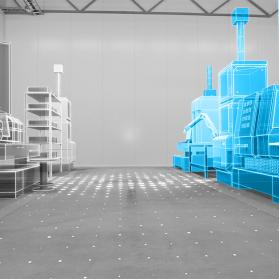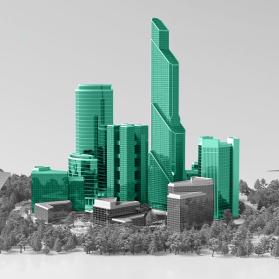Where will our products come from in 2030? Anyone with more than a passing thought about this question should take a look at the project “STOREFACTORY”; adidas has achieved a milestone with the pop-up store “Knit for you”. The store in the Berlin shopping center Bikini is closing after the completion of a successful test phase.
How digital transformation can even be fun
During the course of the purchasing process, customers go through a number of stages. During the “Create” phase, for instance, they can see the projections of various materials right on their own bodies and then take their measurements with the help of “body scanners”. As they go through the various available options, a custom product begins to take shape; once complete, it is manufactured in the mini-factory next to the store within only a short time and can be handed over to the customers.
The Federal Ministry for Economics and Energy that is supporting this project financially describes the concept as follows on its website: STOREFACTORY offers customers an opportunity to design products that are a precise match with their own wishes and then to have the products manufactured right on the site. This project is realized by a production facility in Berlin. Another objective of the STOREFACTORY project is to learn about the acceptance of a customized purchasing process marked by Industry 4.0 through personal experience in the business.”
This example shows that digital transformation and Industry 4.0 need not inevitably turn into horror visions of factory halls without a human being in sight and mass unemployment. It is a matter of how the technology is used. Not only does the customer have a lot of fun with the process, it also creates jobs in a different place.
The role of the digital twin
What does all of this have to do with manufacturing on a factory floor? The underlying digitalization approach is the same. The aim is to digitalize the processes from beginning to end and to enable consistent exchange of data – from the first product idea to product planning to production to the customer care processes after the product is delivered to the customer. What this means concretely for the real product that will later appear is that its first incarnation is as a digital twin.
In the above example, the sweater is first developed in completely digital form and its production is secured virtually – the customer can be assured of receiving the product within a defined delivery period. The data of the product’s digital twin are compared with those of the digital twin of the production. This ensures that all of the tools, machines, and raw materials required for production are available and can also be brought together in the desired form.
By the year 2030, we will also have production procedures and machines that can be used flexibly, i.e., they will no longer be designed exclusively for the production of a specific product. Additive production processes such as 3-D printing, which can already be used today to build complete houses within an acceptable time and at acceptable cost, are one example of such processes, while tools that are set and controlled flexibly using software are another.
Since digital data like the digital twin of a product can be quickly replaced without any restrictions, the actual production site can be located anywhere in the world as long as it has the prerequisite properties. Going back to our example, a customer in Berlin could sit down with a famous designer in a co-creation session to develop a unique sweater and have it printed right in Berlin. By 2030, approaches that are even now visible – the concept of Industrial Data Space in Germany, for instance – can ensure that the intellectual property is protected or, if desired, that the design can be sold to others and produced in return for consideration. The appropriate trustworthy providers of platforms would guarantee this as a digital service.
Urban manufacturing – the factory in the city
Germany is a highly urbanized country. In other words, many people who want to work and go shopping live in cities. Modern technologies are making it possible for more and more production processes to be carried out without harmful emissions of pollutants and noise. So why not locate part of the production in the city? This would also counteract the shortage of professional experts because well-paid knowledge workers would like to take advantage of the broad range of opportunities offered to themselves and their families in the city.
The production zones that remain outside the city can in many cases be highly automated, then supervised, controlled, and optimized by experts with the aid of their own experience data that are stored in the systems or procured from others such as the manufacturers.
In this case, tried and proven methods from the Industrial Revolution could be recycled. In the city, operators of neighborhood factories can maintain flexible, but expensive production facilities and offer them to other specialist manufacturers. One could also imagine the sharing of such resources in the form of cooperatives. In the past, for instance, procurements of expensive agricultural machines such as combines as well as the purchase of goods by the Raiffeisengenossenschaften benefited the farmers who were members of the cooperative; today, we would speak of an ecosystem.
What can manufacturing companies do to make sure they are fit for the digital age?
Develop your digital strategy! Knowledge and use of modern technologies are not enough; there are other parameters of the target markets that must considered when creating the new business models. A study by the foundation "Neue Verantwortung", for example, includes interesting suggestions for the parameters and describes six scenarios for the labor market in Germany in 2030.
Build up your networks! Never before has it been so simple to join up with other people and, by seamlessly exchanging information, to revolutionize the added-value process. And customers should also be integrated into the process.
Be bold with your new business models and roles! Perhaps you will turn out to be exactly the right person to satisfy a need that has just appeared out of nowhere in these value networks. To stay with the above example, you, a successful manufacturer of expensive special machinery such as (body) scanners or laser cutting equipment, could offer your products in these neighborhoods.
It will be best for you to start right now, today, by thinking about the data that are already available, what data would still be good to have, and what you can do with them. Complete your information management strategy for your digital fitness!
We thank Uwe Weber for the work on this article.







